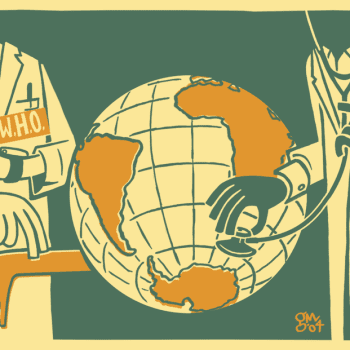[Chief Justice John] Roberts invoked what Lambert calls “a longstanding interpretive canon that calls for the court, if possible, to interpret statutes in a way that preserves their constitutionality.” Roberts did this by ruling that what Congress called a “penalty” for not obeying the mandate was really a tax on noncompliance.
This must, Lambert thinks, have momentous — and deleterious — implications for the functioning of the ACA. The problems arise from the interplay of two ACA provisions — “guaranteed issue” and “community rating.”
The former forbids insurance companies from denying coverage because of a person’s preexisting health condition. The latter, says Lambert, requires insurers to price premiums “solely on the basis of age, smoker status, and geographic area, without charging higher premiums to sick people or those susceptible to sickness.”
The point of the penalty to enforce the mandate was to prevent healthy people — particularly healthy young people — from declining to purchase insurance, or dropping their insurance, which would leave an insured pool of mostly old and infirm people. This would cause the cost of insurance premiums to soar, making it more and more sensible for the healthy to pay the ACA tax, which is much less than the price of insurance.
Roberts noted that a person earning $35,000 a year would pay a $60 monthly tax and someone earning $100,000 would pay $200. But the cost of a qualifying insurance policy is projected to be $400 a month. Clearly, it would be sensible to pay $60 or $200 rather than $400, because if one becomes ill, “guaranteed issue” assures coverage and “community rating” means that one’s illness will not result in higher insurance rates.
So, Lambert says, the ACA’s penalties are too low to prod the healthy to purchase insurance, even given ACA’s subsidies for purchasers. The ACA’s authors probably understood this perverse incentive and assumed that once Congress passed the ACA with penalties low enough to be politically palatable, Congress could increase them.
But Roberts’s decision limits Congress’s latitude by holding that the small size of the penalty is part of the reason it is, for constitutional purposes, a tax. It is not a “financial punishment” because it is not so steep that it effectively prohibits the choice of paying it. And, Roberts noted, “by statute, it can never be more.”As Lambert says, the penalty for refusing to purchase insurance counts as a tax only if it remains so small as to be largely ineffective.
Unable to increase penalties substantially, Congress, in the context of “guaranteed issue” and “community rating,” has only one way to induce healthy people to purchase insurance. This is by the hugely expensive process of increasing premium subsidies enough to make negligible the difference between the cost of insurance to purchasers and the penalty for not purchasing. Republicans will ferociously resist exacerbating the nation’s financial crisis in order to rescue the ACA.
Because the penalties are constitutionally limited by the reasoning whereby Roberts declared them taxes, he may have saved the ACA’s constitutionality by sacrificing its feasibility.
via George Will: The time bomb within Obamacare? – The Washington Post.
Would somebody, preferably a fan of Obamacare, explain to me how this could possibly work? Why would an uninsured person pay $400 a month for insurance when he could pay instead a $60 per month “tax”? (A penalty from disobeying a law might prick his conscience, but a tax carries no such shame.) And if he gets sick, he can just sign up for insurance then (and presumably drop it later), since insurance companies by law have to accept him no matter what?
Also, since insurance companies are micromanaged by the government so that they have to include a whole menu of coverages (such as, notoriously, free contraceptives and abortion drugs, but other things too) and because they cannot control their risks by turning down people with previous conditions and the like, the cost of a policy is projected to be $400 a month. Isn’t that more than the typical cost of insurance? Won’t that dramatically increase medical costs for employers, individuals, those who couldn’t afford insurance even at the earlier prices, and thus, since those folks will have to be subsidized, for the federal government?
How–theoretically, practically, in any way–can this work?
















